Mixed Metal Oxide by Calcination of Layered Double Hydroxide: Parameters Affecting Specific Surface Area
Abstract
1. Introduction
2. Specific Surface Area of MMO Prepared from Calcined LDH
2.1. Importance of Specific Surface Area Control in Industiral Application of MMO
2.1.1. Market and Industry Trend of MMO
2.1.2. Importance of Controlling the Specific Surface Area in Industrial Application
2.2. Controlling the Specific Surface Area of MMO by Calcining Pure LDH
2.2.1. Metal Composition of LDH
- -
- General features
- -
- MgAl-MMO
- -
- ZnAl-MMO
- -
- MgFe-MMO
2.2.2. Temperature Effect on LDH
2.3. Effect of Pore Developoing Agent
- -
- Micelle-Forming Copolymer and Surfactant
- -
- Biomolecules
- -
- The other porogens
3. Conclusions
Author Contributions
Funding
Institutional Review Board Statement
Informed Consent Statement
Data Availability Statement
Conflicts of Interest
References
- Wachs, I.E. Recent conceptual advances in the catalysis science of mixed metal oxide catalytic materials. Catal. Today 2005, 100, 79–94. [Google Scholar] [CrossRef]
- Fan, G.; Sun, W.; Wang, H.; Li, F. Visible-light-induced heterostructured Zn–Al–In mixed metal oxide nanocomposite photocatalysts derived from a single precursor. Chem. Eng. J. 2011, 174, 467–474. [Google Scholar] [CrossRef]
- Pan, D.; Ge, S.; Zhao, J.; Shao, Q.; Guo, L.; Zhang, X.; Lin, J.; Xu, G.; Guo, Z. Synthesis, characterization and photocatalytic activity of mixed-metal oxides derived from NiCoFe ternary layered double hydroxides. Dalton Trans. 2018, 47, 9765–9778. [Google Scholar] [CrossRef] [PubMed]
- Kadam, S.L.; Mane, S.M.; Tirmali, P.M.; Kulkarni, S.B. Electrochemical synthesis of flower like Mn-Co mixed metal oxides as electrode material for supercapacitor application. Curr. Appl. Phys. 2018, 18, 397–404. [Google Scholar] [CrossRef]
- Kitiyanan, A.; Ngamsinlapasathian, S.; Pavasupree, S.; Yoshikawa, S. The preparation and characterization of nanostructured TiO2–ZrO2 mixed oxide electrode for efficient dye-sensitized solar cells. J. Solid State Chem. 2005, 178, 1044–1048. [Google Scholar] [CrossRef]
- Hu, C.; Wang, T.; Dong, J.; Liu, R.; Liu, H.; Qu, J. Capacitive deionization from reconstruction of NiCoAl-mixed metal oxide film electrode based on the “memory effect”. Appl. Surf. Sci. 2018, 459, 767–773. [Google Scholar] [CrossRef]
- Romano, E.J.; Schulz, K.H. A XPS investigation of SO2 adsorption on ceria–zirconia mixed-metal oxides. Appl. Surf. Sci. 2005, 246, 262–270. [Google Scholar] [CrossRef]
- Gao, Y.; Zhang, Z.; Wu, J.; Yi, X.; Zheng, A.; Umar, A.; O’Hare, D.; Wang, Q. Comprehensive investigation of CO2 adsorption on Mg–Al–CO3 LDH-derived mixed metal oxides. J. Mater. Chem. A 2013, 1, 12782–12790. [Google Scholar] [CrossRef]
- Biabani-Ravandi, A.; Rezaei, M.; Fattah, Z. Study of Fe–Co mixed metal oxide nanoparticles in the catalytic low-temperature CO oxidation. Process Saf. Environ. Prot. 2013, 91, 489–494. [Google Scholar] [CrossRef]
- Yang, Y. Recent advances in the electrochemical oxidation water treatment: Spotlight on byproduct control. Front. Environ. Sci. Eng. 2020, 14, 1–12. [Google Scholar] [CrossRef]
- Kapoor, P.N.; Bhagi, A.K.; Mulukutla, R.S.; Klabunde, K.J. Mixed metal oxide nanoparticles. Dekker Encycl. Nanosci. Nanotechnol. 2004, 2007–2015. [Google Scholar] [CrossRef]
- Cousin, P.; Ross, R.A. Preparation of mixed oxides: A review. Mater. Sci. Eng. A 1990, 130, 119–125. [Google Scholar] [CrossRef]
- Rao, C.N.R.; Biswas, K. Essentials of Inorganic Materials Synthesis; John Wiley & Sons: Hoboken, NJ, USA, 2015. [Google Scholar]
- Ogoshi, T.; Chujo, Y. Organic–inorganic polymer hybrids prepared by the sol-gel method. Compos. Interfaces 2005, 11, 539–566. [Google Scholar] [CrossRef]
- Hernández, A.; Maya, L.; Sánchez-Mora, E.; Sánchez, E.M. Sol-gel synthesis, characterization and photocatalytic activity of mixed oxide ZnO-Fe2O3. J. Sol-Gel Sci. Technol. 2007, 42, 71–78. [Google Scholar] [CrossRef]
- Carter, C.B.; Norton, M.G. Sols, gels, and organic chemistry. In Ceramic Materials; Springer: Berlin/Heidelberg, Germany, 2013; pp. 411–422. [Google Scholar]
- Mataji, M.; Ghorbani, M.; Gatabi, M.P. Structural, optical and magnetic properties of novel ZnFe2O4/ZrO2 mixed metal oxide nanocomposite synthesized by hydrothermal technique. J. Alloys Compd. 2018, 757, 298–309. [Google Scholar] [CrossRef]
- Shandilya, M.; Rai, R.; Singh, J. Review: Hydrothermal technology for smart materials. Adv. Appl. Ceram. 2016, 115, 354–376. [Google Scholar] [CrossRef]
- Heredia, A.C.; Oliva, M.I.; Zandalazini, C.I.; Agú, U.A.; Eimer, G.A.; Casuscelli, S.G.; Herrero, E.R.; Pérez, C.F.; Crivello, M.E. Synthesis, Characterization, and Catalytic Behavior of Mg–Al–Zn–Fe Mixed Oxides from Precursors Layered Double Hydroxide. Ind. Eng. Chem. Res. 2011, 50, 6695–6703. [Google Scholar] [CrossRef]
- Heredia, A.C.; Oliva, M.I.; Agú, U.; Zandalazini, C.I.; Marchetti, S.G.; Herrero, E.R.; Crivello, M.E. Synthesis, characterization and magnetic behavior of Mg–Fe–Al mixed oxides based on layered double hydroxide. J. Magn. Magn. Mater. 2013, 342, 38–46. [Google Scholar] [CrossRef]
- Foruzin, L.J.; Rezvani, Z. Ultrasonication construction of the nano-petal NiCoFe-layered double hydroxide: An excellent water oxidation electrocatalyst. Ultrason. Sonochem. 2020, 64, 104919. [Google Scholar] [CrossRef]
- Bao, J.; Wang, Z.; Xie, J.; Xu, L.; Lei, F.; Guan, M.; Zhao, Y.; Huang, Y.; Li, H. A ternary cobalt–molybdenum–vanadium layered double hydroxide nanosheet array as an efficient bifunctional electrocatalyst for overall water splitting. Chem. Commun. 2019, 55, 3521–3524. [Google Scholar] [CrossRef]
- Das, N.; Das, R. Synthesis, characterization and activation of quaternary layered double hydroxides for the one-pot synthesis of methyl isobutyl ketone. React. Kinet. Mech. Catal. 2010, 99, 397. [Google Scholar] [CrossRef]
- Harizi, I.; Chebli, D.; Bouguettoucha, A.; Rohani, S.; Amrane, A. A New Mg–Al–Cu–Fe-LDH Composite to Enhance the Adsorption of Acid Red 66 Dye: Characterization, Kinetics and Isotherm Analysis. Arab. J. Sci. Eng. 2019, 44, 5245–5261. [Google Scholar] [CrossRef]
- Song, F.; Hu, X. Ultrathin Cobalt–Manganese Layered Double Hydroxide Is an Efficient Oxygen Evolution Catalyst. J. Am. Chem. Soc. 2014, 136, 16481–16484. [Google Scholar] [CrossRef]
- Oh, J.-M.; Park, M.; Kim, S.-T.; Jung, J.-Y.; Kang, Y.-G.; Choy, J.-H. Efficient delivery of anticancer drug MTX through MTX-LDH nanohybrid system. J. Phys. Chem. Solids 2006, 67, 1024–1027. [Google Scholar] [CrossRef]
- Li, C.; Wei, M.; Evans, D.G.; Duan, X. Layered Double Hydroxide-based Nanomaterials as Highly Efficient Catalysts and Adsorbents. Small 2014, 10, 4469–4486. [Google Scholar] [CrossRef] [PubMed]
- Choudhary, V.R.; Jha, R.; Jana, P. Solvent-free selective oxidation of benzyl alcohol by molecular oxygen over uranium oxide supported nano-gold catalyst for the production of chlorine-free benzaldehyde. Green Chem. 2007, 9, 267–272. [Google Scholar] [CrossRef]
- Choi, G.; Kim, T.-H.; Oh, J.-M.; Choy, J.-H. Emerging nanomaterials with advanced drug delivery functions; focused on methotrexate delivery. Coord. Chem. Rev. 2018, 359, 32–51. [Google Scholar] [CrossRef]
- Wang, S.L.; Hseu, R.J.; Chang, R.R.; Chiang, P.N.; Chen, J.H.; Tzou, Y.M. Adsorption and thermal desorption of Cr(VI) on Li/Al layered double hydroxide. Colloids Surf. A Physicochem. Eng. Asp. 2006, 277, 8–14. [Google Scholar] [CrossRef]
- Chen, D.; Li, Y.; Zhang, J.; Li, W.; Zhou, J.; Shao, L.; Qian, G. Efficient removal of dyes by a novel magnetic Fe3O4/ZnCr-layered double hydroxide adsorbent from heavy metal wastewater. J. Hazard. Mater. 2012, 243, 152–160. [Google Scholar] [CrossRef]
- Ryu, S.-J.; Jung, H.; Oh, J.-M.; Lee, J.-K.; Choy, J.-H. Layered double hydroxide as novel antibacterial drug delivery system. J. Phys. Chem. Solids 2010, 71, 685–688. [Google Scholar] [CrossRef]
- Stepanova, L.N.; Belskaya, O.B.; Vasilevich, A.V.; Leont’eva, N.N.; Baklanova, O.N.; Likholobov, V.A. Effect of the Composition of Initial Components and the Conditions of Activation on the Mechanochemical Synthesis of Magnesium–Aluminum Layered Double Hydroxides. Kinet. Catal. 2018, 59, 521–531. [Google Scholar] [CrossRef]
- Seiyama, T.; Yamazoe, N.; Eguchi, K. Characterization and activity of some mixed metal oxide catalysts. Ind. Eng. Chem. Prod. Res. Dev. 1985, 24, 19–27. [Google Scholar] [CrossRef]
- Védrine, J.C. Heterogeneous catalysis on metal oxides. Catalysts 2017, 7, 341. [Google Scholar] [CrossRef]
- Velu, S.; Suzuki, K.; Gopinath, C.S. Photoemission and in Situ XRD Investigations on CuCoZnAl-Mixed Metal Oxide Catalysts for the Oxidative Steam Reforming of Methanol. J. Phys. Chem. B 2002, 106, 12737–12746. [Google Scholar] [CrossRef]
- Cho, S.; Jang, J.-W.; Kong, K.-J.; Kim, E.S.; Lee, K.-H.; Lee, J.S. Anion-Doped Mixed Metal Oxide Nanostructures Derived from Layered Double Hydroxide as Visible Light Photocatalysts. Adv. Funct. Mater. 2013, 23, 2348–2356. [Google Scholar] [CrossRef]
- Hu, W.; Wei, H.; She, Y.; Tang, X.; Zhou, M.; Zang, Z.; Du, J.; Gao, C.; Guo, Y.; Bao, D. Flower-like nickel-zinc-cobalt mixed metal oxide nanowire arrays for electrochemical capacitor applications. J. Alloys Compd. 2017, 708, 146–153. [Google Scholar] [CrossRef]
- Miura, N.; Lu, G.; Yamazoe, N. High-temperature potentiometric/amperometric NOx sensors combining stabilized zirconia with mixed-metal oxide electrode. Sens. Actuators B Chem. 1998, 52, 169–178. [Google Scholar] [CrossRef]
- Paul, D.; Neogi, S. Synthesis, characterization and a comparative antibacterial study of CuO, NiO and CuO-NiO mixed metal oxide. Mater. Res. Express 2019, 6, 055004. [Google Scholar] [CrossRef]
- Wang, Y.; Zhang, D.; Lv, D.; Sun, Y. Mg–Al mixed metal oxide film derived from layered double hydroxide precursor film: Fabrication and antibacterial properties. J. Taiwan Inst. Chem. Eng. 2015, 57, 160–166. [Google Scholar] [CrossRef]
- Polychronopoulou, K.; Fierro, J.L.G.; Efstathiou, A.M. Novel Zn–Ti-based mixed metal oxides for low-temperature adsorption of H2S from industrial gas streams. Appl. Catal. B Environ. 2005, 57, 125–137. [Google Scholar] [CrossRef]
- Zhang, Z.-Q.; Liao, M.-C.; Zeng, H.-Y.; Xu, S.; Liu, X.-J.; Du, J.-Z.; Zhu, P.-H.; Huang, Q.-J. Temperature effect on chromium(VI) removal by Mg/Al mixed metal oxides as adsorbents. Appl. Clay Sci. 2014, 102, 246–253. [Google Scholar] [CrossRef]
- Ni, Z.-M.; Xia, S.-J.; Wang, L.-G.; Xing, F.-F.; Pan, G.-X. Treatment of methyl orange by calcined layered double hydroxides in aqueous solution: Adsorption property and kinetic studies. J. Colloid Interface Sci. 2007, 316, 284–291. [Google Scholar] [CrossRef] [PubMed]
- Jiang, D.; Su, L.; Ma, L.; Yao, N.; Xu, X.; Tang, H.; Li, X. Cu–Zn–Al mixed metal oxides derived from hydroxycarbonate precursors for H2S removal at low temperature. Appl. Surf. Sci. 2010, 256, 3216–3223. [Google Scholar] [CrossRef]
- Mochane, M.J.; Magagula, S.I.; Sefadi, J.S.; Sadiku, E.R.; Mokhena, T.C. Morphology, Thermal Stability, and Flammability Properties of Polymer-Layered Double Hydroxide (LDH) Nanocomposites: A Review. Crystals 2020, 10, 612. [Google Scholar] [CrossRef]
- Li, B.; Zhang, Y.; Zhou, X.; Liu, Z.; Liu, Q.; Li, X. Different dye removal mechanisms between monodispersed and uniform hexagonal thin plate-like MgAl–CO32--LDH and its calcined product in efficient removal of Congo red from water. J. Alloys Compd. 2016, 673, 265–271. [Google Scholar] [CrossRef]
- Jung, S.-Y.; Kim, B.-K.; Kim, H.-J.; Oh, J.-M. Development of Mesopore Structure of Mixed Metal Oxide through Albumin-Templated Coprecipitation and Reconstruction of Layered Double Hydroxide. Nanomaterials 2021, 11, 620. [Google Scholar] [CrossRef]
- INNOPOLIS Foundation. Advanced Ceramic Market: Technology Global Market Trend Report; INNOPOLIS Foundation: Daejeon, Korea, 2018; p. 4. [Google Scholar]
- Gawande, M.B.; Pandey, R.K.; Jayaram, R.V. Role of mixed metal oxides in catalysis science—Versatile applications in organic synthesis. Catal. Sci. Technol. 2012, 2, 1113–1125. [Google Scholar] [CrossRef]
- Dzene, L.; Jeguirim, M.; Brendlé, J.; Limousy, L. Second international symposium Clays and ceramics for environmental applications. C. R. Chim. 2019, 22, 103–104. [Google Scholar] [CrossRef]
- Ministry of SMS and Startups. Technology Roadmap for SME 2018–2020; Ministry of SMS and Startups: Daejeon, Korea, 2018; pp. 19–21.
- Arora, A.K.; Jaswal, V.S.; Singh, K.; Singh, R. Applications of metal/mixed metal oxides as photocatalyst: (A review). Orient. J. Chem. 2016, 32, 2035. [Google Scholar] [CrossRef]
- Kim, B.-K.; Gwak, G.-H.; Okada, T.; Oh, J.-M. Effect of particle size and local disorder on specific surface area of layered double hydroxides upon calcination-reconstruction. J. Solid State Chem. 2018, 263, 60–64. [Google Scholar] [CrossRef]
- Millange, F.; Walton, R.I.; O’Hare, D. Time-resolved in situ X-ray diffraction study of the liquid-phase reconstruction of Mg–Al–carbonate hydrotalcite-like compounds. J. Mater. Chem. 2000, 10, 1713–1720. [Google Scholar] [CrossRef]
- Li, D.; Lu, M.; Cai, Y.; Cao, Y.; Zhan, Y.; Jiang, L. Synthesis of high surface area MgAl2O4 spinel as catalyst support via layered double hydroxides-containing precursor. Appl. Clay Sci. 2016, 132–133, 243–250. [Google Scholar] [CrossRef]
- Sun, G.; Sun, L.; Wen, H.; Jia, Z.; Huang, K.; Hu, C. From Layered Double Hydroxide to Spinel Nanostructures: Facile Synthesis and Characterization of Nanoplatelets and Nanorods. J. Phys. Chem. B 2006, 110, 13375–13380. [Google Scholar] [CrossRef] [PubMed]
- Jung, S.-Y.; Kim, B.-K.; Hirata, S.; Inada, M.; Oh, J.-M. Particle size effect of layered double hydroxide on the porosity of calcined metal oxide. Appl. Clay Sci. 2020, 195, 105701. [Google Scholar] [CrossRef]
- Yan, Z.; Zhu, B.; Yu, J.; Xu, Z. Effect of calcination on adsorption performance of Mg–Al layered double hydroxide prepared by a water-in-oil microemulsion method. RSC Adv. 2016, 6, 50128–50137. [Google Scholar] [CrossRef]
- Chen, C.; Yang, M.; Wang, Q.; Buffet, J.-C.; O’Hare, D. Synthesis and characterisation of aqueous miscible organic-layered double hydroxides. J. Mater. Chem. A 2014, 2, 15102–15110. [Google Scholar] [CrossRef]
- Zhu, X.; Chen, C.; Suo, H.; Wang, Q.; Shi, Y.; O’Hare, D.; Cai, N. Synthesis of elevated temperature CO2 adsorbents from aqueous miscible organic-layered double hydroxides. Energy 2019, 167, 960–969. [Google Scholar] [CrossRef]
- Putra, A.T.S.P. An improved method for high photocatalytic performance of ZnAl2O4 spinel derived from layered double hydroxide precursor. SN Appl. Sci. 2020, 2, 842. [Google Scholar] [CrossRef]
- Szabados, M.; Kónya, Z.; Kukovecz, Á.; Sipos, P.; Pálinkó, I. Ultrasonically-assisted mechanochemical synthesis of zinc aluminate spinel from aluminium-rich layered double hydroxide. J. Solid State Chem. 2019, 272, 227–233. [Google Scholar] [CrossRef]
- Magri, V.R.; Duarte, A.; Perotti, G.F.; Constantino, V.R. Investigation of Thermal Behavior of Layered Double Hydroxides Intercalated with Carboxymethylcellulose Aiming Bio-Carbon Based Nanocomposites. ChemEngineering 2019, 3, 55. [Google Scholar] [CrossRef]
- Castro, R.H.R.; Tôrres, R.B.; Pereira, G.J.; Gouvêa, D. Interface Energy Measurement of MgO and ZnO: Understanding the Thermodynamic Stability of Nanoparticles. Chem. Mater. 2010, 22, 2502–2509. [Google Scholar] [CrossRef]
- Gidado, S.M.; Akanyeti, İ. Comparison of Remazol Brilliant Blue Reactive Adsorption on Pristine and Calcined ZnAl, MgAl, ZnMgAl Layered Double Hydroxides. Water Air Soil Pollut. 2020, 231, 146. [Google Scholar] [CrossRef]
- Huang, J.; Yang, Z.; Wang, R.; Zhang, Z.; Feng, Z.; Xie, X. Zn–Al layered double oxides as high-performance anode materials for zinc-based secondary battery. J. Mater. Chem. A 2015, 3, 7429–7436. [Google Scholar] [CrossRef]
- Zhang, L.; Liu, J.; Xiao, H.; Liu, D.; Qin, Y.; Wu, H.; Li, H.; Du, N.; Hou, W. Preparation and properties of mixed metal oxides based layered double hydroxide as anode materials for dye-sensitized solar cell. Chem. Eng. J. 2014, 250, 1–5. [Google Scholar] [CrossRef]
- Starukh, H.; Levytska, S. The simultaneous anionic and cationic dyes removal with ZnAl layered double hydroxides. Appl. Clay Sci. 2019, 180, 105183. [Google Scholar] [CrossRef]
- Huang, G.; Sun, Y.; Zhao, C.; Zhao, Y.; Song, Z.; Chen, J.; Ma, S.; Du, J.; Yin, Z. Water–n-BuOH solvothermal synthesis of ZnAl–LDHs with different morphologies and its calcined product in efficient dyes removal. J. Colloid Interface Sci. 2017, 494, 215–222. [Google Scholar] [CrossRef]
- Das, J.; Patra, B.S.; Baliarsingh, N.; Parida, K.M. Calcined Mg–Fe–CO3 LDH as an adsorbent for the removal of selenite. J. Colloid Interface Sci. 2007, 316, 216–223. [Google Scholar] [CrossRef]
- Türk, T.; Alp, İ.; Deveci, H. Adsorption of As(V) from water using Mg–Fe-based hydrotalcite (FeHT). J. Hazard. Mater. 2009, 171, 665–670. [Google Scholar] [CrossRef]
- Yang, Y.; Gao, N.; Deng, Y.; Zhou, S. Adsorption of perchlorate from water using calcined iron-based layered double hydroxides. Appl. Clay Sci. 2012, 65–66, 80–86. [Google Scholar] [CrossRef]
- Peng, C.; Dai, J.; Yu, J.; Yin, J. Calcined Mg-Fe layered double hydroxide as an absorber for the removal of methyl orange. AIP Adv. 2015, 5, 057138. [Google Scholar] [CrossRef]
- Xu, Y.; Liu, T.; Huang, Y.; Zhu, J.; Zhu, R. Role of phosphate concentration in control for phosphate removal and recovery by layered double hydroxides. Environ. Sci. Pollut. Res. 2020, 27, 16612–16623. [Google Scholar] [CrossRef]
- Zhang, Z.; Xu, S.; Zeng, H.; Liao, M.; Du, J.; Duan, H. Influence of Calcination Temperature on the Microstructure and Catalytic Performance of Mg/Al Hydrotalcites Catalysts for Alcoholysis of Propylene Oxide. J. Nanosci. Nanotechnol. 2016, 16, 12677–12683. [Google Scholar] [CrossRef]
- Lonkar, S.P.; Kutlu, B.; Leuteritz, A.; Heinrich, G. Nanohybrids of phenolic antioxidant intercalated into MgAl-layered double hydroxide clay. Appl. Clay Sci. 2013, 71, 8–14. [Google Scholar] [CrossRef]
- Ray, S.; Joy, M.; Sa, B.; Ghosh, S.; Chakraborty, J. pH dependent chemical stability and release of methotrexate from a novel nanoceramic carrier. RSC Adv. 2015, 5, 39482–39494. [Google Scholar] [CrossRef]
- Chakraborty, M.; Dasgupta, S.; Soundrapandian, C.; Chakraborty, J.; Ghosh, S.; Mitra, M.K.; Basu, D. Methotrexate intercalated ZnAl-layered double hydroxide. J. Solid State Chem. 2011, 184, 2439–2445. [Google Scholar] [CrossRef]
- Starukh, G. Photocatalytically Enhanced Cationic Dye Removal with Zn-Al Layered Double Hydroxides. Nanoscale Res. Lett. 2017, 12, 391. [Google Scholar] [CrossRef]
- Zhang, Y.; Li, X. Preparation of Zn-Al CLDH to Remove Bromate from Drinking Water. J. Environ. Eng. 2014, 140, 04014018. [Google Scholar] [CrossRef]
- Miessler, G.L.; Fischer, P.J.; Tarr, D.A. Inorganic Chemistry; Pearson: London, UK, 2014. [Google Scholar]
- Han, Y.-J.; Kim, J.M.; Stucky, G.D. Preparation of Noble Metal Nanowires Using Hexagonal Mesoporous Silica SBA-15. Chem. Mater. 2000, 12, 2068–2069. [Google Scholar] [CrossRef]
- Bui, T.X.; Choi, H. Adsorptive removal of selected pharmaceuticals by mesoporous silica SBA-15. J. Hazard. Mater. 2009, 168, 602–608. [Google Scholar] [CrossRef]
- Mesa, M.; Sierra, L.; Patarin, J.; Guth, J.-L. Morphology and porosity characteristics control of SBA-16 mesoporous silica. Effect of the triblock surfactant Pluronic F127 degradation during the synthesis. Solid State Sci. 2005, 7, 990–997. [Google Scholar] [CrossRef]
- Hwang, Y.K.; Chang, J.-S.; Kwon, Y.-U.; Park, S.-E. Microwave synthesis of cubic mesoporous silica SBA-16. Microporous Mesoporous Mater. 2004, 68, 21–27. [Google Scholar] [CrossRef]
- Wang, J.; Zhou, J.; Li, Z.; He, Y.; Lin, S.; Liu, Q.; Zhang, M.; Jiang, Z. Mesoporous mixed metal oxides derived from P123-templated Mg–Al layered double hydroxides. J. Solid State Chem. 2010, 183, 2511–2515. [Google Scholar] [CrossRef]
- Pahalagedara, M.N.; Pahalagedara, L.R.; Kuo, C.-H.; Dharmarathna, S.; Suib, S.L. Ordered Mesoporous Mixed Metal Oxides: Remarkable Effect of Pore Size on Catalytic Activity. Langmuir 2014, 30, 8228–8237. [Google Scholar] [CrossRef] [PubMed]
- Oka, Y.; Kuroda, Y.; Matsuno, T.; Kamata, K.; Wada, H.; Shimojima, A.; Kuroda, K. Preparation of Mesoporous Basic Oxides through Assembly of Monodispersed Mg–Al Layered Double Hydroxide Nanoparticles. Chem. A Eur. J. 2017, 23, 9362–9368. [Google Scholar] [CrossRef]
- Xie, J.; Yamaguchi, T.; Oh, J.-M. Synthesis of a mesoporous Mg–Al–mixed metal oxide with P123 template for effective removal of Congo red via aggregation-driven adsorption. J. Solid State Chem. 2021, 293, 121758. [Google Scholar] [CrossRef]
- Li, X.; Xiao, W.; He, G.; Zheng, W.; Yu, N.; Tan, M. Pore size and surface area control of MgO nanostructures using a surfactant-templated hydrothermal process: High adsorption capability to azo dyes. Colloids Surf. A Physicochem. Eng. Asp. 2012, 408, 79–86. [Google Scholar] [CrossRef]
- Rani, K.M.; Palanisamy, P.N. Synthesis and Characterization of Mesoporous, Nanostructured Zinc Aluminium Carbonate Layered Double Hydroxides (ZAC-LDHs) and Its Calcined Product (CZA-LDH). J. Inorg. Organomet. Polym. Mater. 2018, 28, 1127–1135. [Google Scholar] [CrossRef]
- Zhao, L.; Xu, T.; Lei, X.; Xu, S.; Zhang, F. Scalable preparation of alginate templated-layered double hydroxide mesoporous composites with enhanced surface areas and surface acidities. J. Nanosci. Nanotechnol. 2011, 11, 3291–3297. [Google Scholar] [CrossRef]
- Duan, S.-C.; Meng, Z.-Z.; Xie, J.; Chen, C.-X. Preparation and Catalytic Property of ZnAlCe Ternary Complex Oxide Porous Materials Based on Rape Pollen Biotemplates. J. Inorg. Mater. 2015, 4, 420–426. [Google Scholar] [CrossRef]
- Wang, D.; Li, S.; Du, Y.; Wu, X.; Chen, Y. Self-Templating Synthesis of 3D Hierarchical NiCo2O4@NiO Nanocage from Hydrotalcites for Toluene Oxidation. Catalysts 2019, 9, 352. [Google Scholar] [CrossRef]
- Xiang, X.; Hima, H.I.; Wang, H.; Li, F. Facile Synthesis and Catalytic Properties of Nickel-Based Mixed-Metal Oxides with Mesopore Networks from a Novel Hybrid Composite Precursor. Chem. Mater. 2008, 20, 1173–1182. [Google Scholar] [CrossRef]
- Feng, R.; Al-Megren, H.A.; Zhang, Z.; Al-Kinany, M.C.; Yan, Z.; Zhang, Z.; Gao, X. Soft-templating pathway to create nanostructured Mg–Al spinel as high-temperature absorbent for SO2. J. Porous Mater. 2014, 21, 947–956. [Google Scholar] [CrossRef]
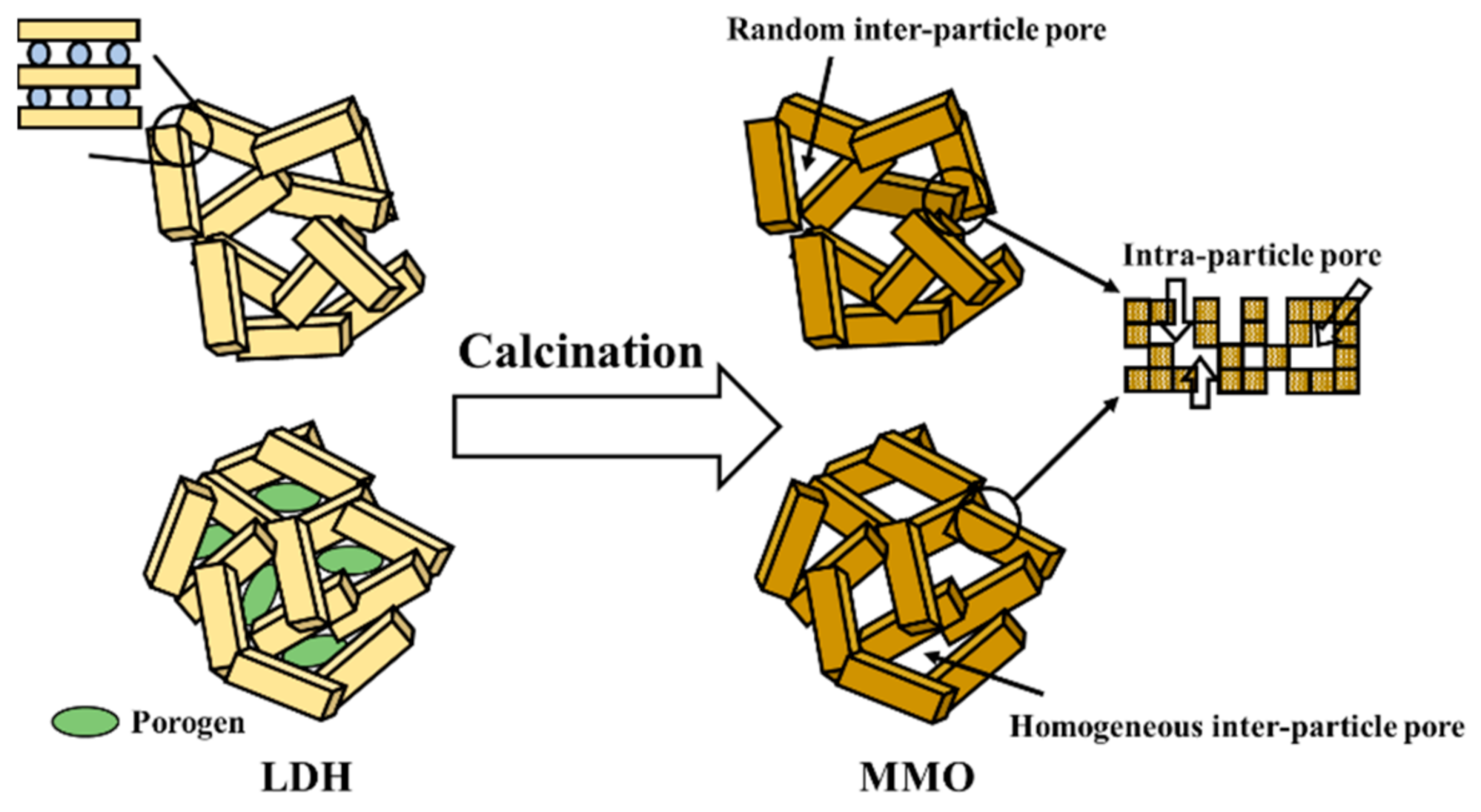

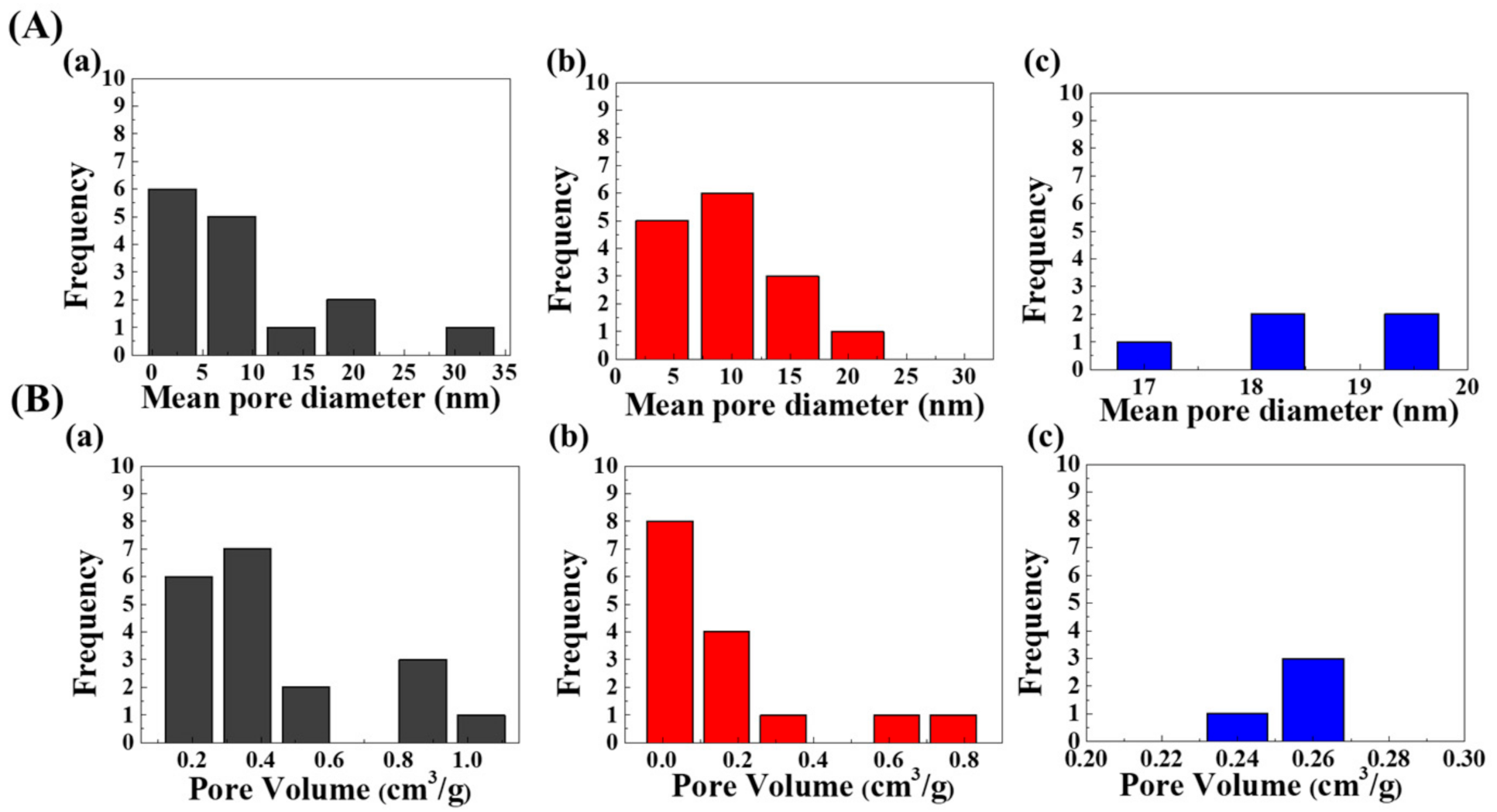
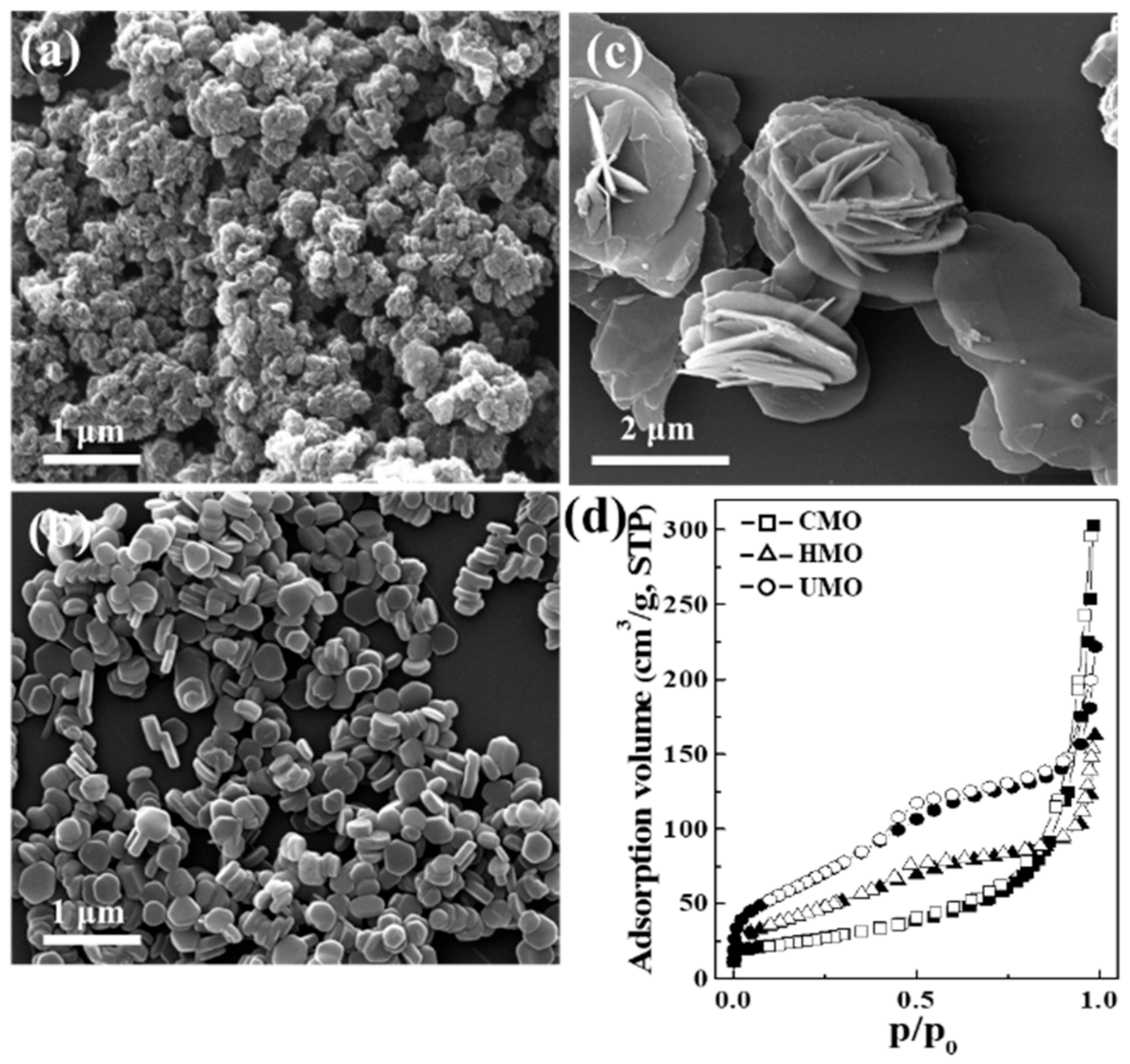
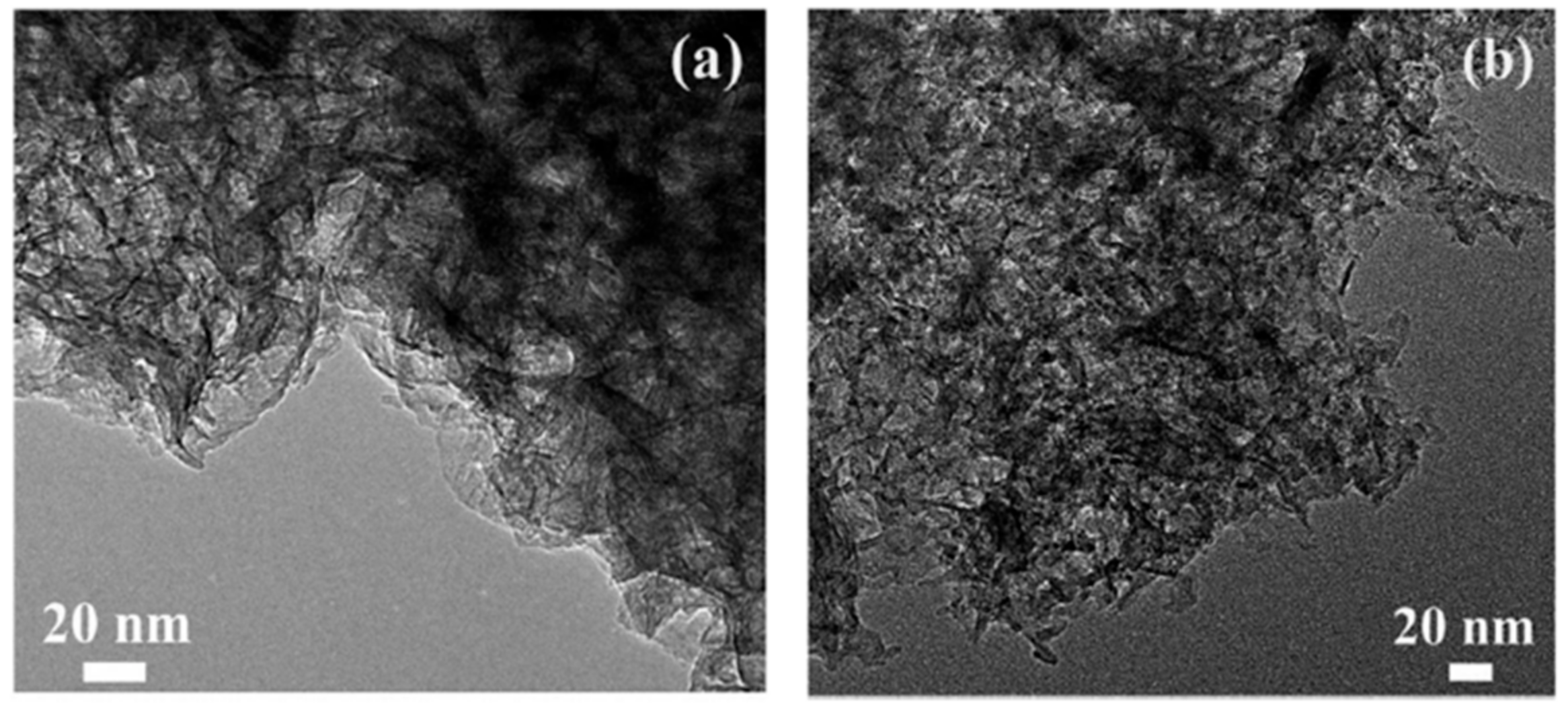

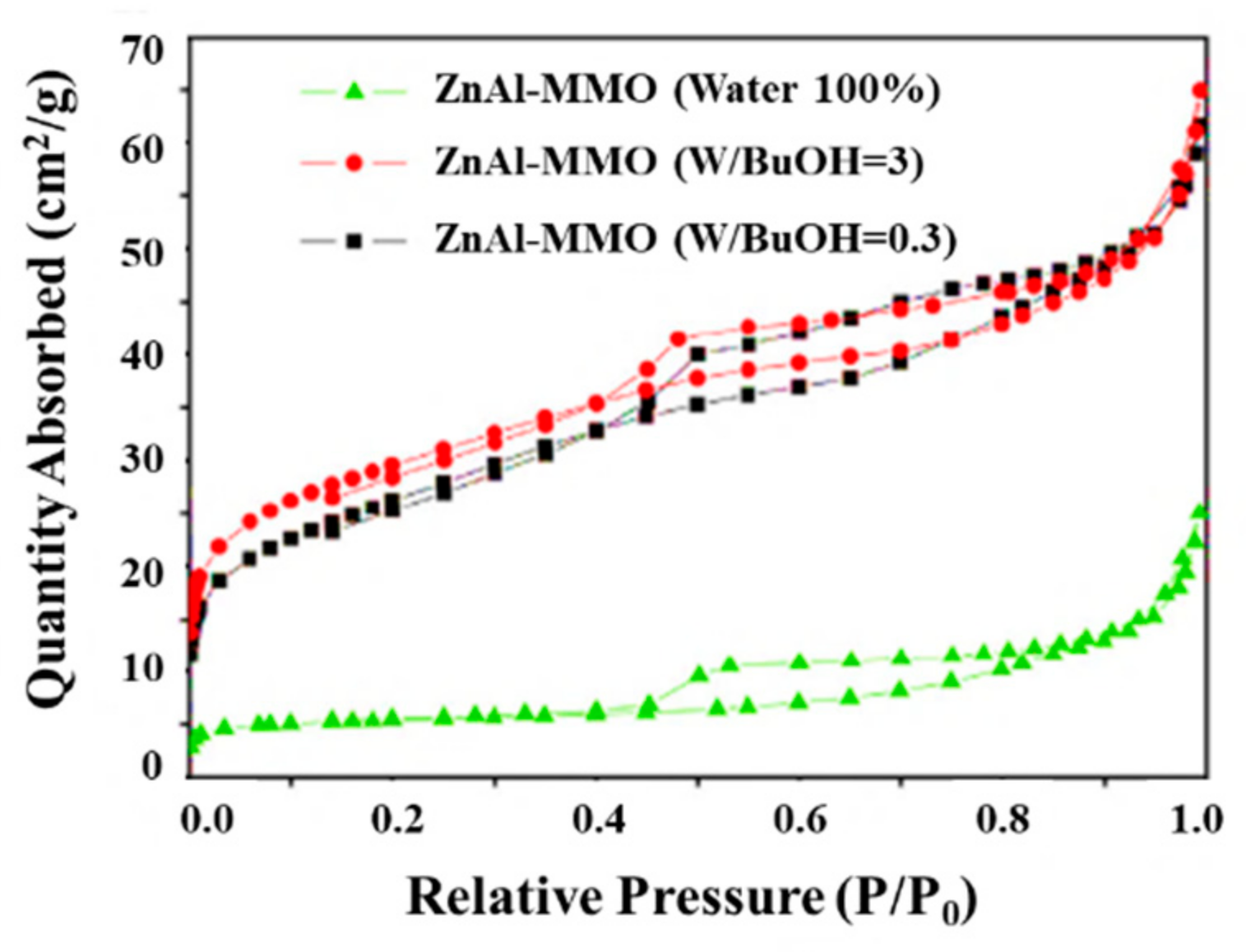

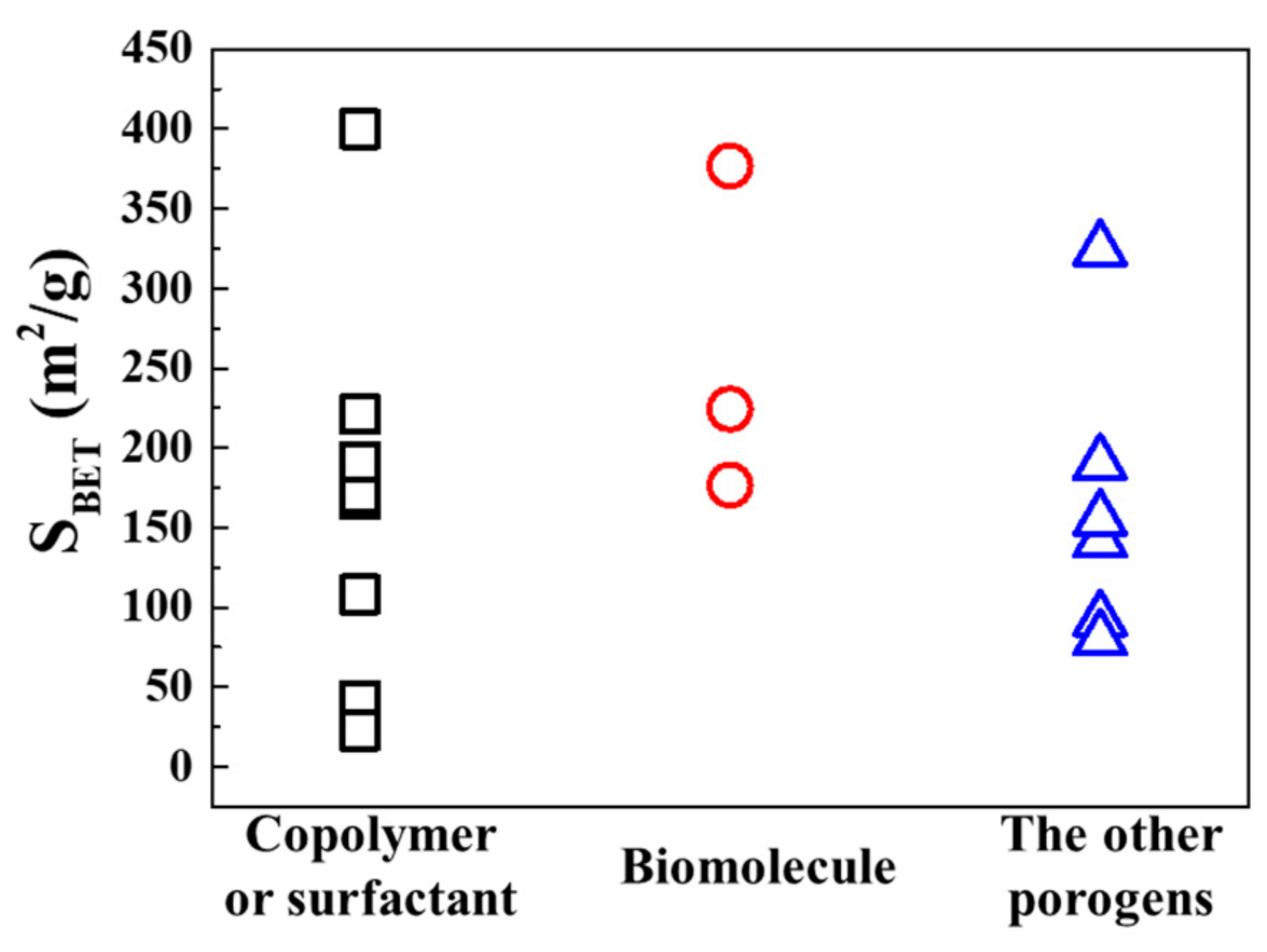

| Metal Composition | Interlayer Anion | Temperature (°C) | SBET (m2/g) | Ref. |
|---|---|---|---|---|
| MgAl | CO32− | 450 °C | 204 m2/g | [4] |
| 450 °C | 75–143 m2/g | [8] | ||
| 450 °C | 108–163 m2/g | [8] | ||
| 450 °C | 216–292 m2/g | [9] | ||
| 450 °C | 59 m2/g | [12] | ||
| 450 °C | 209 m2/g | [14] | ||
| 450 °C | 60–133 m2/g | [16] | ||
| 450 °C | 32.9 m2/g | [17] | ||
| 500 °C | 180–210 m2/g | [1] | ||
| 500 °C | 117.6 m2/g | [7] | ||
| 500 °C | 91–250 m2/g | [15] | ||
| 700 °C | 165.1 m2/g | [11] | ||
| 750 °C | 80.4 m2/g | [13] | ||
| 300–600 °C | 210–320 m2/g | [2] | ||
| 200–1000 °C | 55–150 m2/g | [3] | ||
| 400–600 °C | 38–187 m2/g | [5] | ||
| 300–700 °C | 44–58 m2/g | [6] | ||
| 200–600 °C | 80–246 m2/g | [10] | ||
| ZnAl | CO32− | 370 °C | 80 m2/g | [30] |
| 400 °C | 20–104 m2/g | [25] | ||
| 450 °C | 32.9 m2/g | [29] | ||
| 500 °C | 122 m2/g | [23] | ||
| 500 °C | 129 m2/g | [26] | ||
| 500 °C | 28–86 m2/g | [27] | ||
| 500 °C | 143.3 m2/g | [28] | ||
| 500 °C | 109.5 m2/g | [7] | ||
| 300–600 °C | 51–91 m2/g | [24] | ||
| 200–1000 °C | 6–43 m2/g | [18] | ||
| NO3− | 750 °C | 22.5 m2/g | [20] | |
| 150–600 °C | 29–82 m2/g | [31] | ||
| 300–700 °C | 15–46 m2/g | [19] | ||
| 500–700 °C | 60–71 m2/g | [21] | ||
| Cl− | 50–400 °C | 102–221 m2/g | [22] | |
| MgFe | CO32− | 350 °C | 108–144 m2/g | [45] |
| 350–550 °C | 92–96 m2/g | [44] | ||
| 400 °C | 74 m2/g | [48] | ||
| 450 °C | 205 m2/g | [46] | ||
| 500 °C | 168 m2/g | [32] | ||
| 500 °C | 44.3 m2/g | [35] | ||
| 500 °C | 81–127 m2/g | [37] | ||
| 500 °C | 86–128 m2/g | [42] | ||
| 600 °C | 185 m2/g | [43] | ||
| 600 °C | 110 m2/g | [47] | ||
| 150–600 °C | 99–202 m2/g | [38] | ||
| 300–500 °C | 104–196 m2/g | [39] | ||
| 400–500 °C | 116–218 m2/g | [40] | ||
| 200–600 °C | 8–49 m2/g | [33] | ||
| 450–550 °C | 92–112 m2/g | [41] | ||
| NO3− | 300–700 °C | 65–86 m2/g | [34] | |
| 500–600 °C | 78–110 m2/g | [36] | ||
| Cl− | 500–600 °C | 75–110 m2/g | [46] |
| Porogen | Metal Composition | SBET (m2/g) | Ref. | |
|---|---|---|---|---|
| Micelle forming copolymer or surfactants | P123 | MgAl | 13–180 m2/g | [87] |
| 179–221 m2/g | [90] | |||
| F127 | NiAl | 97–184 m2/g | [88] | |
| MgAl | 239–400 m2/g | [89] | ||
| Dioctyl sulfosuccinate | Mg | 41–192 m2/g | [91] | |
| cetyltrimethylammonium bromide | ZnAl | 9–31 m2/g | [92] | |
| Biomolecule | Albumin | MgAl | 176–225 m2/g | [48] |
| Sodium Alginate | MgAl | 123–377 m2/g | [93] | |
| Rape pollen | ZnAlCe | 97–113 m2/g | [94] | |
| The others | MOF | CoNi | 64–127 m2/g | [95] |
| Glucose | NiAl | 144–288 m2/g | [96] | |
| MgAl | 151–323 m2/g | [97] | ||
Publisher’s Note: MDPI stays neutral with regard to jurisdictional claims in published maps and institutional affiliations. |
© 2021 by the authors. Licensee MDPI, Basel, Switzerland. This article is an open access article distributed under the terms and conditions of the Creative Commons Attribution (CC BY) license (https://creativecommons.org/licenses/by/4.0/).
Share and Cite
Lee, S.-B.; Ko, E.-H.; Park, J.Y.; Oh, J.-M. Mixed Metal Oxide by Calcination of Layered Double Hydroxide: Parameters Affecting Specific Surface Area. Nanomaterials 2021, 11, 1153. https://doi.org/10.3390/nano11051153
Lee S-B, Ko E-H, Park JY, Oh J-M. Mixed Metal Oxide by Calcination of Layered Double Hydroxide: Parameters Affecting Specific Surface Area. Nanomaterials. 2021; 11(5):1153. https://doi.org/10.3390/nano11051153
Chicago/Turabian StyleLee, Su-Bin, Eun-Hye Ko, Joo Y. Park, and Jae-Min Oh. 2021. "Mixed Metal Oxide by Calcination of Layered Double Hydroxide: Parameters Affecting Specific Surface Area" Nanomaterials 11, no. 5: 1153. https://doi.org/10.3390/nano11051153
APA StyleLee, S.-B., Ko, E.-H., Park, J. Y., & Oh, J.-M. (2021). Mixed Metal Oxide by Calcination of Layered Double Hydroxide: Parameters Affecting Specific Surface Area. Nanomaterials, 11(5), 1153. https://doi.org/10.3390/nano11051153






